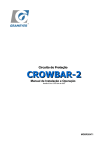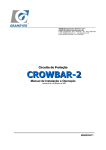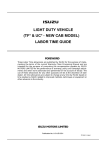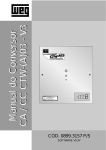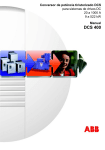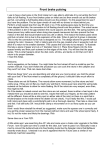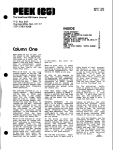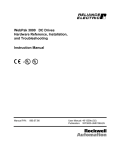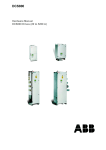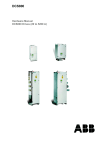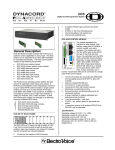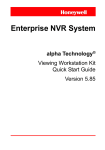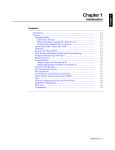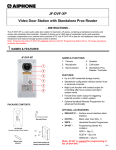Download DCS 400 Service Manual
Transcript
DCS Thyristor Power Converters for DC drive systems 20 to 1000 A Service Manual DCS 400 Thyristor Power Converters Series DCS 400 Service Manual Code: 3ADW 000 131 R0101 Rev A SM4_E_A.DOC EFFECTIVE: SUPERSEDES: 2001 ABB Automation Products GmbH. All rights reserved. May 17th, 2001 none DCS 400 Service Manual Safety Instructions Overview This chapter contains safety instructions that must be complied with during installation, operation and maintenance of the power converter series DCS 400. If these instructions are not complied with, this may result in injuries (perhaps even with fatal consequences) or in damage to the power converter, the motor and the driven machine. Before starting with any work whatsoever at or with this unit, you must read the information given in this chapter. Warnings Warnings provide information on states, which if the specified procedure for the state concerned is not meticulously complied with may result in a serious error, in major damage to the unit, in injury to persons, and even in death. They are identified by the following symbols: Danger: High Voltage! This symbol warns you of high voltages, which may result in injuries to persons and/or damage to equipment. Where appropriate, the text printed adjacent to this symbol describes how risks of this kind may be avoided. ● ● ● ● DCS 400 Service Manual All electrical installation and maintenance work on the thyristor power converter must be carried out by properly qualified staff who has been thoroughly trained in electrical engineering. The thyristor power converter and its adjacent units must be properly earthed by qualified professionals. You must NEVER perform any work on the thyristor power converter while it is still switched on. First switch the unit off, use a measuring instrument to make absolutely sure that the power converter has really been de-energised, and only then you may start with the work concerned. Due to external control circuits, there may be dangerously high voltages present at the thyristor power converter even after the line voltage has been switched off. So always work at the unit with appropriate caution! Non-compliance with these instructions may result in injury (or even death!). i Safety Instructions General warning: this symbol warns you of nonelectrical risks and dangers, which may result in serious or even fatal injury to persons, and/or in damage to equipment. Where appropriate, the text printed adjacent to this symbol describes how risks of this kind may be avoided. ● When thyristor power converters are in use, the electric motors, power transmission elements and the driven machines are working in an extended operating range, which means they have to cope with a relatively high loading. ● You should have made sure that all units, devices and appliances used are actually suitable for this higher loading. ● If you have to operate the thyristor power converter at a rated motor voltage and/or a rated motor current significantly below the figures stated in the thyristor power converter's output data, you must take appropriate precautionary measures to protect the unit against overspeed, overload, breakage, etc., by modifying the software or hardware appropriately. ● For insulation testing, you must disconnect all cables from the thyristor power converter. You should avoid operating your unit at values other than the rated data. Non-compliance with these instructions may cause lasting damage to the thyristor power converter. ● The thyristor power converter possesses a number of automatic reset functions. When these functions are executed, the unit will be reset after an error and will then resume operation. These functions should not be used if other units and devices are not suitable for an operating mode of this kind, or if their use might entail dangerous situations. Warning of electrostatic discharge: this symbol warns you against electrostatic discharges, which may damage the unit. Where appropriate, the text printed next to this symbol describes how a risk of this kind may be avoided. ii DCS 400 Service Manual Safety Instructions Notes Notes supply information on states requiring particular attention, or indicate that additional information is available on a specific topic. For this purpose, the following symbols are used: CAUTION! Cautions are designed to draw your attention to a particular state of affairs. Note A note contains or refers you to additional information available on the particular topic concerned. Mains connection You can use a switch disconnector (with fuses) in the power supply of the thyristor power converter to disconnect the electrical components of the unit from the power supply for installation and maintenance work. The type of disconnector used must be a switch disconnector as per EN 60947-3, Class B, so as to comply with EU regulations, or a circuit-breaker type which switches off the load circuit by means of an auxiliary contact causing the breaker's main contacts to open. The mains disconnector must be locked in its "OPEN" position during any installation and maintenance work. EMERGENCY STOP buttons EMERGENCY STOP buttons must be installed at each control desk and at all other control panels requiring an emergency stop function. Pressing the STOP button on the DCS400-PAN control panel of the thyristor power converter will neither cause an emergency motor stop, nor will the drive be disconnected from any dangerous potential. Intended use The operating instructions cannot take into consideration every possible case of configuration, operation or maintenance. Thus, they mainly give such advice only, which is required by qualified personnel for normal operation of the machines and devices in industrial installations. If in special cases the electrical machines and devices are intended for use in non-industrial installations - which may require stricter safety regulations (e.g. protection against contact by children or similar) -, these additional safety measures for the installation must be provided by the customer during assembly. DCS 400 Service Manual iii Contents Service Manual Safety Instructions Chapter 1 - Introduction How to use this manual............................................................................................................. 1-1 Contents of this manual ............................................................................................................ 1-1 Target group.............................................................................................................................. 1-1 Associated publications ........................................................................................................... 1-2 Storage and transport ............................................................................................................... 1-2 Rating plate ............................................................................................................................... 1-2 Example......................................................................................................................... 1-2 Chapter 2 - Dismounting the Converter Main components of DCS400 module...................................................................................... 2-1 Frame size A1 ............................................................................................................... 2-1 Frame size A2 ............................................................................................................... 2-2 Frame size A3 ............................................................................................................... 2-2 Frame size A4 ............................................................................................................... 2-3 Open the converter ................................................................................................................... 2-3 Controller frame in maintenance position ................................................................................. 2-4 Remove controller board SDCS-CON-3(A).............................................................................. 2-5 Remove the entire controller frame .......................................................................................... 2-5 Remove power interface board SDCS-PIN-3(A) ...................................................................... 2-6 Remove field exciter SDCS-FIS-3(A) ....................................................................................... 2-6 Chapter 3 - Controller board SDCS-CON-3(A) Short test of inputs / outputs ..................................................................................................... 3-1 Analogue Inputs ............................................................................................................ 3-1 Analogue Outputs.......................................................................................................... 3-1 Digital Inputs.................................................................................................................. 3-1 Digital Outputs............................................................................................................... 3-2 Supply Voltages ............................................................................................................ 3-2 Voltage for reference potentiometer........................................................................... 3-2 Encoder supply ........................................................................................................... 3-2 Digital Inputs (Digital Output circuits) ......................................................................... 3-2 Fieldbus Adapter......................................................................................................... 3-2 Other helpful measuring points ..................................................................................... 3-4 Burden adaptation ......................................................................................................... 3-5 Overview burden adaptation per converter module ................................................................. 3-6 2-Q converters............................................................................................................... 3-6 4-Q converters............................................................................................................... 3-6 Example ...................................................................................................................... 3-7 Chapter 4 - Power interface board SDCS-PIN-3(A) Power supply............................................................................................................................. 4-1 Behavior of fault............................................................................................................. 4-2 Field choke connection ............................................................................................................. 4-3 iv DCS 400 Service Manual Contents SDCS-PIN-3 ................................................................................................................4-3 SDCS-PIN-3AX............................................................................................................4-3 SDCS-PIN-3A..............................................................................................................4-3 Chapter 5 - Field Exciter Unit SDCS-FIS-3(A) Test of SDCS-FIS-3(A) ..............................................................................................................5-1 Start conditions ..............................................................................................................5-1 Preparation.....................................................................................................................5-1 Necessary drive modifications .......................................................................................5-1 Test field voltage ............................................................................................................5-2 Test field current ............................................................................................................5-3 Exchange of Field Exciter Unit SDCS-FIS-3(A) ........................................................................5-5 Required Tools...............................................................................................................5-5 Disassemble Field Exciter Unit ......................................................................................5-5 Assemble new Field Exciter Unit ...................................................................................5-7 Chapter 6 - Thyristor Modules Fault tracing ...............................................................................................................................6-1 Thyristor diagnosis .........................................................................................................6-1 Diagnosis result ...........................................................................................................6-1 Blown fuse......................................................................................................................6-2 Faulty thyristor .............................................................................................................6-2 Firing pulses...............................................................................................................................6-3 Generation .....................................................................................................................6-3 Power measuring values ...............................................................................................6-4 Temperature of thyristor bridge .................................................................................................6-5 Snubber circuit ...........................................................................................................................6-6 General Instruction for Handling Semiconductors ....................................................................6-7 Exchange of Thyristor Module...................................................................................................6-8 Required Tools...............................................................................................................6-8 Disassemble Thyristor modules.....................................................................................6-8 Assemble the new module.............................................................................................6-9 Thyristor module location in DCS 401 (2-Q) units.......................................................6-11 Thyristor module location in DCS 402 (4-Q) units.......................................................6-12 Module terminals..........................................................................................................6-13 Chapter 7 - Preventive Maintenance Recommended Regular Maintenance.......................................................................................7-1 Air Filters ........................................................................................................................7-1 Fan .................................................................................................................................7-1 Heatsink .........................................................................................................................7-1 Appendix A - Spare Parts List Spare parts quick finder for 2-Quadrant (2-Q) DCS 400 series (DCS 401.0xxx).................... A-1 Spare parts quick finder for 4-Quadrant (4-Q) DCS 400 series (DCS 402.0xxx).................... A-2 Appendix B - Circuit diagrams Block diagram DCS 401 ........................................................................................................... B-1 Block diagram DCS 402 ........................................................................................................... B-2 Appendix C - Compatibility Hardware / Software DCS 400 Service Manual v Contents PCB’s as spare parts ................................................................................................................C-1 Comparison of features.............................................................................................................C-2 Drive Firmware Update .............................................................................................................C-3 Replace Firmware 107.3 (or earlier) to 108.0 on an existing SDCS-CON-3 board .....C-3 Replace SDCS-CON-3 with firmware 107.x by SDCS-CON-3 with firmware108.0.....C-5 Replace SDCS-CON-3 by SDCS-CON-3A ..................................................................C-6 Replace SDCS-CON-3A by SDCS-CON-3A ................................................................C-7 vi DCS 400 Service Manual Chapter 1 - Introduction How to use this manual The purpose of this service manual is to provide detailed information on how to exchange thyristors and Printed Circuit Boards (PCB) installed in power converters from the DCS 400 series. Contents of this manual Chapter 1 - Introduction This chapter informs about the contents and the use of this manual as well as about the boundary conditions applying. Chapter 2 - Dismounting the converter This chapter describes how to dismount the converter. Chapter 3 - Controller board SDCS-CON-3(A) This chapter describes how to test the controller board and the burden adaptation. Chapter 4 - Power interface board SDCS-PIN-3(A) This chapter describes specialities of the power interface board. Chapter 5 - Field Exciter Unit SDCS-FIS-3(A) This chapter describes the exchange of field exciter unit mounted in converter. Chapter 6 - Thyristor modules This chapter describes the fault tracing, handling and exchanging of thyristor modules for frame sizes A1...A4 as well as some special data (firing pulses, temperature of thyristor bridge, I²t values and so on). Chapter 7 - Preventive Maintenance This chapter describes the measures for preventive maintenance of the thyristor converters. Appendix A - Spare Parts list The appendix A contains the spare parts list of the converters. Appendix B- Circuit diagrams The appendix B shows specific circuit diagrams. Appendix C- Compatibility of Hardware / Software This appendix describes the permissible configurations depending on the different hard- and software possibilities. Furthermore the procedures for updating the Drive's firmware is shown. Target group This manual is designed to help those responsible for planning, installing, starting up and servicing the thyristor power converter. These people should possess • basic knowledge of physics and electrical engineering, electrical wiring principles, components and symbols used in electrical engineering, and • basic experience with DC drives and products. DCS 400 Service Manual 1 - 1 Chapter 1 - Introduction Associated publications The Manual DCS 400 (publication no. 3ADW 000 095) includes the following: System overview Technical data Overview of software Installation Operating instructions Serial interfaces Storage and transport If the unit had been in storage prior to installation or is transported to another location, care must be taken to ensure that the environmental conditions are complied with (see Manual DCS 400). CAUTION! The thyristor power converter weighs quite a lot and should therefore not be held by the front cover. Please put the unit down only on its back. Always use due care when handling the unit, so as to avoid injuries or damage. Rating plate For purposes of identification, each thyristor power converter is fitted with a rating plate, stating the type code and the serial number, which serve as individual identification of each unit. The type code contains information on the characteristics and the configuration of the unit. Example ABB Automation Products GmbH Type: DCS402.0050 REV.A.1 Ser No: 7042176 A049 1234 ❘❙❚❘❙❚❘❙❚❘❙❚❘❙❚❘❙❚❘❙❚❘❙❘❙❘❙❘❙❘❙❘❙❘❙❘❙❘❙❚❘❙❚❘❙❚❘❙❚❘❙❚❘❙ Type DCS402.0050 REV.A.1 DCS402. 0050 DCS401.0230 REV.A.1 DCS401. 0230 REV.A.1 1 - 2 Made in Germany U1 3~230…500 V I1 41 A f1 50 / 60 Hz Fan U2 I2 IF 115 / 230 V 240…520 VDC 50 A 6 A rating plate 4-Q converter nominal DC current in Amps (50 A) rating plate 2-Q converter nominal DC current in Amps (230 A) Revision status A: - new PCB’s SDCS-CON-3A, SDCS-PIN-3A , SDCS-FIS-3A - improved analogue I/O resolution 12 bit - new internal field choke - increased field current rating 4/6/16/20 A - increased field voltage range 50…440 V DCS 400 Service Manual Chapter 1 - Introduction Ser No 7042176 A 0 49 1234 7042176 A 0 49 1234 Fan 115 / 230 V U1 3~230…500 V U2 240…520 VDC I1 I2 f1 IF 41 A 50 A 50 / 60 Hz 6A No Revision status: - depending on SDCS-CON-3(A): Analogue resolution 10 / 8 (12) Bit - independing on used PCB‘s: Field current rating 6 / 16 / 16 A Field voltage range 50…350 V Serial no. Manufacturing number for identification Index Year of production (double character up to Oct. 99, afterwards single character) week of production current number Fan supply 115 VAC or 230 VAC DCS401.0020 / DCS402.0025 without fan Mains supply 230 VAC to 500 VAC , 3-phase Converter nominal DC voltage 240 V to 520 V (U2 = 240 V at U1 = 230 V) (U2 = 520 V at U1 = 500 V) Converter nominal AC current 41 A Converter nominal DC current 50 A Frequency 50 Hz or 60 Hz Field current nominal 6 A The technical data and specifications are valid as of going to press. ABB reserves the right to make subsequent alterations. If you have any questions concerning your drive system, please contact your local ABB agent. DCS 400 Service Manual 1 - 3 Chapter 1 - Introduction 1 - 4 DCS 400 Service Manual Chapter 2 - Dismounting the Converter Before you start work, disconnect the converter completely from the power supply then check the voltage free condition and make sure, everything is located in an electrically and mechanically safe condition! The main components of DCS 400 (4-Q units) are shown in the figures below. Main components of DCS400 module Frame size A1 1 2 3 4 5 6 7 8 9 10 11 12 13 14 15 16 17 18 19 20 21 22 23 Lid Cover PCB Panel adapter PCB SDCS-CON-3(A) Base plate of electronic MP capacitor PCB SDCS-PIN-3(A) InsulationPlate Spacer stud Current transformer Busbars Terminal sensor Choke PCB SDCS-FIS-3(A) Thyristor modul Distanz nut Terminal block Heatsink Housing Fan Top plate Fan terminal Screws Fig. 2-1 DCS 400 Service Manual 3-D drawing of the DCS 400 Frame size A1 2 - 1 Chapter 2 – Dismounting the Converter Frame size A2 1 2 3 4 5 6 7 8 9 10 11 12 13 14 15 16 17 18 19 20 21 Lid Cover PCB Panel adapter PCB SDCS-CON-3(A) MP capacitor PCB SDCS-PIN-3(A) Current transformer Thyristor modul Choke Thermal sensor PCB SDCS-FIS-3(A) Housing Fan Fan terminal Top plate Base plate of electronic Spacer stud Busbars Heatsink Terminal block Screws Fig. 2-2 3-D drawing of the DCS 400 Frame size A2 Fig. 2-3 3-D drawing of the DCS 400 Frame size A3 Frame size A3 1 2 3 4 5 6 7 8 9 10 11 12 13 14 15 16 17 18 19 20 21 22 Lid Cover Edional Cover Base plate of electronic MP capacitor PCB SDCS-CON-3(A) PCB Panel adapter Spacer stud PCB SDCS-PIN-3(A) Current transformer Busbars Distanz nut Terminal block Choke Terminal sensor PCB SDCS-FIS-3(A) Thyristor modul Heatsink Housing Fan Fan terminal Top plate 2 - 2 DCS 400 Service Manual Chapter 2 - Dismounting the Converter Frame size A4 Lid Cover Edional Cover Base plate of electronic MP capacitor PCB SDCS-CON-3(A) PCB Panel adapter Spacer stud PCB SDCS-PIN-3(A) Current transformer Busbars Distanz nut Heatsink Choke Terminal sensor PCB SDCS-FIS-3(A) Thyristor modul Heatsink Housing Fan Fan terminal Top plate Fig. 2-4 Open the converter • • • • 3-D drawing of the DCS 400 Frame size A4 Remove the panel DCS400PAN. Loose (not remove) the screws at the top of the converter and behind the flap. Remove the top cover plate incl. fan. Remove the front cover. loose 1 2 3 4 5 6 7 8 9 10 11 12 13 14 15 16 17 18 19 20 21 22 remove Fig. 2-5 DCS 400 Service Manual Open the converter 2 - 3 Chapter 2 – Dismounting the Converter Controller frame in maintenance position For test purposes the controller frame can be set in a maintenance position. Danger: Safety instructions must be followed • When working on live drive converters, the applicable national accident prevention (e.g. VBG 4) must be complied with. • When switched on high voltage is applied to the DC link capacitor. Remove controller frame: • • Loose (don’t remove) fixing screws of controller frame. Lift up the frame approx. 1 cm and take it out to the front. remove entire controller frame Fig. 2-6 Attach controller frame in maintenance position: • Fix clamp of the mounting plate (upper left) to eye in the housing (upper right). • Establish ground potential between housing and mounting plate. High voltage Mains voltage * 1.35 Fig. 2-7 2 - 4 Removing the Controller board for fixing in maintenance position Controller board in maintenance position DCS 400 Service Manual Chapter 2 - Dismounting the Converter Remove controller board SDCS-CON-3(A) • • • • • Remove flat cable connectors X12 / X13. Remove panel adapter PCB at X7. Remove I / O terminal plugs X1…X8. If necessary remove optical cable at V800. Remove fixing screws of controller board. remove SDCS-CON-3(A) from controller frame Fig. 2-8 Remove the entire controller frame • • • • • • DCS 400 Service Manual Remove flat cable connectors X12 / X13. Remove plugs at the DC link capacitor. Loose (don’t remove) fixing screws of controller frame. Remove I / O terminal plugs X1…X8. If necessary remove optical cable at V800. Lift up the frame around 1 cm and take it out to the front. Removing Controller board remove entire controller frame Fig. 2-9 Remove Controller frame 2 - 5 Chapter 2 – Dismounting the Converter Remove power interface board SDCS-PIN-3(A) • Pay attention to the wire at terminal X100: Please remember the number of windings through current transformer T2 ! T2 remove X100 Module size A1 Þ three A2 … A4 Þ one • • • Remove field exciter SDCS-FIS-3(A) Disconnect all the electrical plugs. Remove all fixing screws and bolts. Pull board downward about 5 cm from clutch and remove straight forward. Fig. 2-10 Caution! After power down please wait at least 30 s for discharging the capacitor! SDCS-FIS-3(A) Fig. 2-11 • • • 2 - 6 Disconnect all the electrical plugs. Remove all fixing screws. Do not forget to add thermal joint compound when exchanging. Remove PIN board Field exciter location remove Fig. 2-12 Remove field exciter DCS 400 Service Manual Chapter 3 - Controller board SDCS-CON-3(A) Short test of inputs / outputs Analogue Inputs Precondition for the short tests is to switch on the electronics supply voltage. AI1: • Connect a potentiometer to AI1. • Select parameter AI1 Act (6.26) at the operating panel. • Changes of the potentiometer are displayed at the panel. SDCS-CON-3(A) AI1 AI2 0V +10V _ + _ + X2: 1 2 3 4 5 6 AI2: • Connect a potentiometer to AI2. • Select parameter AI2 Act (6.27) at the operating panel. • Changes of the potentiometer are displayed at the panel. Analogue Outputs AO1: • Connect a potentiometer to AI1 or AI2. • Set parameter AO1 Assign (6.05) to AI1 Act or AI2 Act. • Connect a voltmeter to terminal X2:8 (+) and X2:5 (0V). • Changes of the potentiometer are shown at the voltmeter. AO2: • Connect a potentiometer to AI1 or AI2. • Set parameter AO2 Assign (6.08) to AI1 Act or AI2 Act. • Connect a voltmeter to terminal X2:9 (+) and X2:5 (0V). • Changes of the potentiometer are shown at the voltmeter. Set back parameter AOx Assign (6.0x) to the original value. Digital Inputs DCS 400 Service Manual • Select parameter DI Act (6.28) at the operating panel. • Switch off all digital inputs. • In case of faults or alarms press ENTER button. State of digital inputs must be displayed as 0000HEX. Switch on DI1 Ł panel display = 0001HEX, switch off DI1. Switch on DI2 Ł panel display = 0002HEX, switch off DI2. Switch on DI3 Ł panel display = 0004HEX, switch off DI3. Switch on DI4 Ł panel display = 0008HEX, switch off DI4. Switch on DI5 Ł panel display = 0010HEX, switch off DI5. Switch on DI6 Ł panel display = 0020HEX, switch off DI6. Switch on DI7 Ł panel display = 0040HEX, switch off DI7. Switch on DI8 Ł panel display = 0080HEX, switch off DI8. 3 - 1 Chapter 3 – Controller board SDCS-CON-3(A) Digital Outputs Disconnect terminal at the desired digital output: DO1 = X5:1 or DO2 = X5:2 or DO3 = X5:3 or DO4 = X5:4 or DO5 = X98:1 + X98:2 DO1…DO4: • Connect a voltmeter to the desired terminal X5:1/2/3/4 and X5:5 (0V). • Set parameter DOx Assign (6.1x) to none. • Voltmeter Þ 0V. • Set parameter DOx Assign (6.1x) to constant 1. • Voltmeter Þ +24V. DO5: • Connect an ohmmeter to terminal X98:1 and X98:2. • Set parameter DO5 Assign (6.15) to none. • Ohmmeter Þ ∞ Ω . • Set parameter DO5 Assign (6.15) to constant 1. • Ohmmeter Þ 0 Ω . Set back parameter DOx Assign (6.1x) to the original value Supply Voltages All of the supply voltages are measurable at the terminals. If a voltage is missing at the terminals it is also measurable at IC’s at the controller board (be carefully). Terminals Þ Þ Þ Voltage for reference potentiometer X2:5 = 0V X2:6 = +10V X2:7 = -10V Encoder supply X3:7 = 0V Þ X3:8 = +U depends on Jumper S2 S2:10-11 = +5V Þ S2:11-12 = +24V Þ Digital Inputs (Digital Output circuits) Fieldbus Adapter 3 - 2 Controller board SDCS-CON-3(A) Frame IC A200: 8 IC A200:14 Frame Jumper S2:10 IC A300: heatsink X4: 9 = +24V X4:10 = 0V Þ Þ IC A501: heatsink Frame X8:1 = +24V X8:2 = 0V Þ Þ IC A501: heatsink Frame DCS 400 Service Manual Chapter 3 - Controller board SDCS-CON-3(A) Fig. 3-1 Supply voltages on CON-3(A) board DCS 400 Service Manual 3 - 3 Chapter 3 – Controller board SDCS-CON-3(A) Other helpful measuring points Fig. 3-2 3 - 4 Helpful measuring points on CON-3(A) board DCS 400 Service Manual Chapter 3 - Controller board SDCS-CON-3(A) Burden adaptation DCS400 is equipped with a 16 step burden resistor adaptation controlled by software. Depending on actual armature current of the motor set in parameter Arm Cur Nom (1.01) the right burden resistor is switched on. It is necessary to increase the current transfer ratio when increasing motor current. With the smallest step of 25 A and 16 steps a current up to 400 A could be handled by using a current transformer ratio of 1500:1. Currents greater then 400 A need a greater transformer ratio. Used current transformer ratios: 25 A to 275 A 1500:1 276 A to 800 A 3000:1 801 A to 1200 A 4500:1 For that the possible current ranges are: Transformer ratio Current range 1500:1 25 A … 400 A (in steps of 25 A) 3000:1 50 A … 800 A (in steps of 50 A) 4500:1 75 A … 1200 A (in steps of 75 A) If armature current nominal set by parameter Arm Cur Nom (1.01) fits to the steps given by the switched steps then the burden voltage is 2 V. The switched burden resistors are: 120 Ω / 250 mW ± 0,1 % ± 0,1 % 60 Ω / 250 mW ± 0,1 % 30 Ω / 500 mW ± 0,1 % 15 Ω / 1 W current transformer 1500 : 1 I DC burden adaptation controlled by software 2 3 4 15 Ω 30 Ω 2V ≈ Iarmnommotor 1 60 Ω 120 Ω 120 Ω base burden resistor Fig. 3-3 DCS 400 Service Manual Switched burden resistors 3 - 5 Chapter 3 – Controller board SDCS-CON-3(A) Overview burden adaptation per converter module 2-Q converters if parameter Arm Cur Nom (1.01) is in a range: Current transformer Size from 4 A to 25 A 26 A 50 A 51 A 75 A 76 A 100 A 101 A 125 A 126 A 150 A 151 A 175 A 176 A 200 A 201 A 225 A 226 A 250 A 1500:1 DCS401. DCS401. DCS401. DCS401. DCS401. DCS401. DCS401. 0020 0045 0065 0090 0125 0180 0230 A1 A1 A1 A1 A1 A2 A2 0…25A 0…50A 0…75A 0…100A 0…125A 0…150A 0…175A 0…200A 0…225A 0…250A then the burden voltage (IDC ) 0...2 V corresponds to if parameter Arm Cur Nom (1.01) is in a range: Current transformer Size from 4 A 51 A to 50 A 100 A 101 A 150 A 151 A 200 A 201 A 250 A 251 A 300 A 301 A 350 A 351 A 400 A 401 A 450 A 451 A 500 A 501 A 550 A 551 A 600 A 601 A 650 A 651 A 700 A 701 A 750 A 3000:1 DCS401. DCS401. DCS401. DCS401. DCS401. 0315 0405 0500 0610 0740 A3 A3 A3 A4 A4 0…50A 0…100A 0…150A 0…200A 0…250A 0…300A 0…350A 0…400A 0…450A 0…500A 0…550A 0…600A 0…650A 0…700A 0…750A then the burden voltage (IDC ) 0...2 V corresponds to if parameter Arm Cur Nom (1.01) is in a range: Current transformer Size from 4 A 76 A to 75 A 150 A 151 A 225 A 226 A 300 A 301 A 375 A 376 A 450 A 451 A 525 A 526 A 600 A 601 A 675 A 676 A 750 A 751 A 825 A 826 A 900 A 4500:1 DCS401. 0900 A4 0…75A 0…150A 0…225A 0…300A 0…375A 0…450A 0…525A 0…600A 0…675A 0…750A 0…825A 0…900A then the burden voltage (IDC ) 0...2 V corresponds to 4-Q converters if parameter Arm Cur Nom (1.01) is in a range: Current transformer Size from 4 A to 25 A 26 A 50 A 51 A 75 A 76 A 100 A 101 A 125 A 126 A 150 A 151 A 175 A 176 A 200 A 201 A 225 A 226 A 250 A 221 A 275 A 1500:1 DCS402. DCS402. DCS402. DCS402. DCS402. DCS402. DCS402. 0025 0050 0075 0100 0140 0200 0260 A1 A1 A1 A1 A1 A2 A2 0…25A 0…50A 0…75A 0…100A 0…125A 0…150A 0…175A 0…200A 0…225A 0…250A 0…275A then the burden voltage (IDC ) 0...2 V corresponds to if parameter Arm Cur Nom (1.01) is in a range: Current transformer Size from 4 A 51 A to 50 A 100 A 101 A 150 A 151 A 200 A 201 A 250 A 251 A 300 A 301 A 350 A 351 A 400 A 401 A 450 A 451 A 500 A 501 A 550 A 551 A 600 A 601 A 650 A 651 A 700 A 3000:1 DCS402. DCS402. DCS402. DCS402. 0350 0450 0550 0680 A3 A3 A3 A4 0…50A 0…100A 0…150A 0…200A 0…250A 0…300A 0…350A 0…400A 0…450A 0…500A 0…550A 0…600A 0…650A 0…700A then the burden voltage (IDC ) 0...2 V corresponds to if parameter Arm Cur Nom (1.01) is in a range: Current transformer Size from 4 A 76 A to 75 A 150 A 151 A 225 A 226 A 300 A 301 A 375 A 376 A 450 A 451 A 525 A 526 A 600 A 601 A 675 A 676 A 750 A 751 A 825 A 826 A 900 A 901 A 975 A 976 A 1050 A 4500:1 DCS402. 0820 DCS402. 1000 A4 A4 0…75A 0…150A 0…225A 0…300A 0…375A 0…450A 0…525A 0…600A 0…675A 0…750A 0…825A 0…900A 0…975A 0…1050A then the burden voltage (IDC ) 0...2 V corresponds to 3 - 6 DCS 400 Service Manual Chapter 3 - Controller board SDCS-CON-3(A) Example Burden voltage (0…2 V) depends on chosen burden resistor and parameter Arm Cur Nom (1.01). e.g. • Used converter should be DCS401.0740. • Armature current Arm Cur Nom (1.01) should be 670 A. • Armature current 670 A is in a range of 651…700 A, that means 0…700 A corresponds to 0…2 V burden voltage. • 100% of actual armature current is 670 A , the corresponding burden voltage is 2 V / 700 A x 670 A = 1,91 V. The burden circuitry is able to process values up to 4 V, therefore a maximum armature current of 200% is possible to represent. DCS 400 Service Manual 3 - 7 Chapter 3 – Controller board SDCS-CON-3(A) 3 - 8 DCS 400 Service Manual Chapter 4 - Power interface board SDCS-PIN-3(A) Power supply The power supply of the DCS 400 series is a wide range input fly back converter. Regulation for the 5 V is done on the SDCS-PIN3(A) board with the reference value coming from the controller board SDCS-CON-3(A). The output of the 5 V regulator is send to the primary side of the power supply via an opto-coupler. All voltages will follow the regulated 5 V supply depending on the load of each output. The following voltages are available at SDCS-PIN-3(A) board: +5V; ±0,1V / 0.5A to supply the controller, the digital logic and an encoder ±15V; ±5% / 0.1A to supply the analogue integrated circuits to supply the digital inputs / outputs, encoder +24V; ±5% / 0.4A and fieldbus adapter to supply the firing pulse amplifiers +40V; ±5% / 0.2A The voltages with there tolerances are designed to feed their nominal load. With suppressed firing pulses for example the output of the +40 V will rise up to +50 V. At the controller board SDCS-CON-3(A) there are some additional voltage regulators available: Encoder: +24V / 0.2A set by jumper, short circuit protected. Reference: ±10V; 0.01A generated from ±15V. Panel: +12V generated from +15V. Fieldbus adapter, digital inputs / outputs: +24V; 0.2A continuously / 0.6A for a short time, short circuit protected DCS 400 Service Manual 4 - 1 Chapter 4 - Power interface board SDCS-PIN-3(A) +Uf SDCS-FIS 3(A) control monitor windings of the choke I F connection passing the current transformer (3 times with 4/6 A units; once with 16/20A units) connection for converter PTC signal on heatsink shows typical voltage of SMP primary side 500 V - potential max. 600 V firing pulses 0V connection to SDCS-CON-3(A) 230 V - potential Ground 0 V reference of SMP signal primary side ground - potential Ground + - connectors of the current transformers fuses for field supply DO 5 SMP supply voltage field supply Fig. 4-1 Behavior of fault SDCS-PIN-3(A) If there is a short circuit at one or more outputs or the fly back converter will be overloaded, the power supply tries to start. If it is not successful it tries again in a few seconds interval. This behaviour could be heard and be seen at the blinking sevensegment-display if the +5 V is not short-circuited. Nevertheless there are running modes of the power supply possible in case of a short circuit which will damage diodes at the secondary side of the fly back converter. During running the power supply without controller board the voltages will rise to values outside the specified tolerances. These voltages are not very stable they will not endanger any parts of the power supply. 4 - 2 DCS 400 Service Manual Chapter 4 - Power interface board SDCS-PIN-3(A) Field choke connection SDCS-PIN-3 Old field choke (3ADT748069/70) connected to X11:2 + X11:3. SDCS-PIN-3AX Temporary PCB (C503 / R512 manually mounted at the PCB). Will be replaced by SDCS-PIN-3A. New field choke (3ADT748073/74) connected to X11:1 + X11:3 Final PCB (C503 / R512 included in PCB layout). New field choke (3ADT748073/74) connected to X11:1 + X11:3 SDCS-PIN-3A FIS-3(A) field choke PIN-3(A) ...73/74 ...69/70 (old) Fig. 4-2 DCS 400 Service Manual Connection of old / new field choke 4 - 3 Chapter 4 - Power interface board SDCS-PIN-3(A) 4 - 4 DCS 400 Service Manual Chapter 5 –Field Exciter Unit SDCS-FIS-3(A) Test of SDCS-FIS-3(A) Start conditions The test includes a check of the field voltage and field current operation. Previously some measures have to be taken. • • • • Preparation • • • • • Drive software version 108.0 or higher Parameter Arm Volt Nom (1.02) is in accordance to the Mains Supply Voltage, see DCS 400 Manual; page 2-3 table 2.2/4 Parameter Net Underv Trip (1.10) is in a range of -10…+5% Parameter Field Heat Ref (4.10) = 0% or greater than Field Low Trip (4.06) Needed tools: Voltmeter 0…1000 V DC, perhaps an ON switch or customer‘s panel. Switch all power OFF Disconnect the motor field at terminals X10:1 and 2 Connect a Voltmeter to terminals X10:1 and 2 Connect an ON switch to terminals X4:7 (DI7-ON) and X4:9 (+24V) or use customer’s panel Necessary drive modifications Mains Supply K1 Unet DC link (V) (V) 230 380 400 415 440 460 480 500 Main Contactor K1 is controlled by DO5 DCS400 DO5 311 513 540 560 594 621 648 675 X10: X4: 1 2 + - . 6 7 8 9 . for this check: parameter DO5 Assign (6.15) has to be set to Constant 1 for resident mains supply ON voltmeter 0…1000V_DC Fig. 5-1 DCS 400 Service Manual Measures for test 5 - 1 Chapter 5 – Field Exciter Unit SDCS-FIS-3(A) Test field voltage (Field disconnected) Actions Be careful now because of high voltage at the unit. Remarks Up to 700 V possible at terminals X10: Switch on electronics supply. Connect mains supply. If main contactor is controlled by digital output DO5 set parameter DO5 Assign (6.15) = Constant 1 to connect DCS 400 power part to mains supply, but remember old value of parameter 6.15 (mostly "macro depend“). Voltmeter should show 0 V. If not: SDCS-FIS-3(A) is faulty / short circuit. Switch on (ON=1) the drive. Volt meter should show the DC link voltage of the IGBT field exciter. DC link voltage = mains supply voltage * 1.35 If not: SDCS-FIS-3(A) is faulty / broken. Switch off (ON=0) the drive within 10 sec. Otherwise an alarm Field Volt Limited (A7) and a fault Field Undercurrent (F12) will occur and switch off the drive. In any case Voltmeter should show 0 V again. 5 - 2 DCS 400 Service Manual Chapter 5 - Field Exciter Unit SDCS-FIS-3(A) Restore the drive to the original state Original state means: Mains Supply K1 Main Contactor K1 is controlled by DO5 DCS400 DO5 X10: X4: 1 2 + - . 6 7 8 9 . ON voltmeter 0…1000V_DC Fig. 5-2 Test field current Original state Test if field current regulator works right (field connected) Actions Switch all power OFF. Disconnect the plug of terminal X10 and measure resistance (Remeas) of motor field using an Ohmmeter. Remarks Remeas = measured value of field resistance. Connect the plug again Calculate the resistance of motor field using field voltage nominal (Ue) and field current nominal (Ie) of motor name plate (warm state). Compare the measured and calculated values in consideration of warm and cold state of the motor. Remember the deviation between warm and cold motor field is approx. -35%. DCS 400 Service Manual Recalc = Uemotor name plate / Iemotor name plate Remeas is approx. Recalc - 35%. It’s only a first rough estimation. If the comparison is out of this range there is something wrong with the motor field. 5 - 3 Chapter 5 – Field Exciter Unit SDCS-FIS-3(A) Be careful now because of high voltage at the unit. Up to 700 V possible at terminals X10: Switch on electronics supply 5 - 4 Switch on (ON=1, RUN=0) the drive. Mains supply has to be available now. Measure field voltage actual (Ueact) of the motor using a Voltmeter. Because of warm or cold state of motor field the deviation of the field voltage can be approx. -35% referring to the motor name plate. Measure field current actual (Ieact) using parameter Field Cur Act (4.02). If Field Cur Act (4.02) is not stable check stability of mains supply voltage, additionally refer to fault description F12/F13 (chapter 6) of the DCS400 Manual. Set temporary Net Underv Trip (1.10)=0% and Net Fail Time=0.5s Calculate the resistance of motor field again using Ueact and Ieact values of the field. React = Ueact / Ieact Values of motor field resistance measured by Ohmmeter and calculated by using actual values (Ueact / Ieact) have to be almost identical. Remeas = React If not there is something wrong with the SDCS-FIS-3(A). DCS 400 Service Manual Chapter 5 - Field Exciter Unit SDCS-FIS-3(A) Exchange of Field Exciter Unit SDCS-FIS-3(A) All DCS 400 converters are equipped with field exciter unit based on IGBT technology. In order to keep the operating temperature of the IGBT module low, the joint between the heatsink and the module should have a good heat conducting ability. The electrical conductivity of the connectors must also be good. For this reason the following instructions must be observed with particular care. Required Tools Special tools or material needed in addition to standard tools for the exchange of field exciter units: - torque socket spanner: 5 Nm (case to heatsink) - torque screwdriver: 3 Nm (electrical connection) - screws are metric type; use appropriate nuts - thermal joint compound (silicon-free grease): type Berlub FZ1/E3 number: GHSN 39 00 11 P1 Field exciter units are always mounted in the same direction, independent of current, voltage, number of quadrants (2-Q or 4-Q). Before you start work, disconnect the converter completely from the power supply then check the voltage free condition and make sure, everything is located in an electrically and mechanically safe condition! Disassemble Field Exciter Unit Dismount field exciter unit as described in chapter 2, additionally pay attention to the following information. In order to obtain access to the field exciter unit from the power interface board SDCS-PIN-3(A), loosen the screws C1, U1, V1, W1 and D1 as well as the bolts (with an 8 mm socket wrench) left and right on the PIN-board. detach the connectors X11, X14, X15, X16 and X22 on the PIN-board. unclamp the connecting cable of the filter choke L1 (sits directly on heatsink) from plug X100 and unwind the cable from the current transformer T2, see Figure 5-3. DCS 400 Service Manual 5 - 5 Chapter 5 – Field Exciter Unit SDCS-FIS-3(A) Filter choke L1 (on Heatsink) Filter choke L1 (on Heatsink) T2 (on PIN-Board) T2 (on PIN-Board) to clamp connector X100: to clamp connector X100: Note: 1 Winding for A2, A3, A4 Frames (Field current IF = 16/20 A) Note: 3 Windings for A1 Frames (Field current IF = 4/6 A) Figure 5-3 Direction and number of windings depending on the field current (type of frame) - shift the power interface board together with the transparent plastic insulation (see Figure 5-6) towards the bottom of the converter and detach the connector X6 from the field exciter unit (FIS-board). If the connecting cables of the connectors X1, X2, X7 as well as X3, X4, X5 are long enough the PIN-board can be shifted in order access the field exciter unit (FIS- board). Otherwise the power interface board and the transparent plastic insulation have to be removed completely by detaching the connectors X1, X2, X7 as well as X3, X4, X5 from the PIN-board. Remove the field exciter unit (FIS- board) by carrying out the following instructions: Detach all connectors X1 to X5, X7 and X14 from the FIS. Be careful not to mix up the connectors! Unscrew the field exciter unit (see Figure 5-4) and mark it clearly. 5 - 6 DCS 400 Service Manual Chapter 5 - Field Exciter Unit SDCS-FIS-3(A) High voltage Umains x 1.35 U1 Umains V1 W1 +U DC Link Ground IGBT modul -U DC Link PWM Connection to SDCS-PIN-3(A) Mounting holes -U DC Link (zero volt signal on high voltage side) ground - potential Figure 5-4 Assemble new Field Exciter Unit 1. Remove old thermal joint compound (grease) from the heatsink. Preparation of the heatsink: if the area is clean, spread out the remaining heat-conducting compound with a rubber spatula or with the hand. If the area is dirty, wipe the heatsink surface clean with tissue paper. Clean the mounting surfaces with an appropriate solvent. 2. Apply a thin coat of thermal compound to the new IGBT-module of the new field exciter unit, refer to Figure 5-5. Spread the thermal joint compound evenly by moving the module forward and backward on the heatsink. Figure 5-5 DCS 400 Service Manual Field Exciter Unit SDCS-FIS-3A Application of thermal compound to IGBT-module 5 - 7 Chapter 5 – Field Exciter Unit SDCS-FIS-3(A) 3. Tighten the clamping screws (IGBT-module to heatsink) to 5 Nm mounting torque and the screw for electrical connection to 3 Nm mounting torque (refer to Figure 5-4). 4. Reattach all connectors X1 to X5, X7 and X14 to the field exciter unit. 5. In order to ensure compatibility between revision stands of field exciter unit (FIS-board) and power interface board (PIN- board), refer to Appendix C Compatibility Hardware/Software for more information before continuing with step 6. Figure 5-6 The transparent plastic insulation 6. Push the transparent plastic insulation (Figure 5-6) and the PINboard back into place (see Figure 5-7), if they were not removed completely. Otherwise put them back in place. Reattach the connector X6 from PIN-board to FIS-board. Ensure that the connecting cables for the connectors X1, X2, X7 as well as X3, X4, X5 are led through the corresponding holes or slits to the front of the PIN-board. 5 - 8 DCS 400 Service Manual Chapter 5 - Field Exciter Unit SDCS-FIS-3(A) Figure 5-7 Positioning of the PIN-board 7. Reattach the connectors X1, X2, X7 as well as X3, X4, X5. 8. Reattach the connectors X11, X14, X15, X16 and X22. 9. Lead connecting cable from filter choke L1 once (for IF = 16/20 A) or three times (for IF = 4/6 A) through the current transformer T2 and clamp it to connector X100, see Figure 5-3. 10. Screw the PIN-board into place. 11. Reattach the ribbon cables on the controller panel to the connectors X12 and X13 on the PIN-board and screw the controller panel back into place. 12. Reattach the connecting cables to the dc-link capacitor. 13. Attach the top cover (with fan, in case of IDC ≥ 45 A) and the front cover and tighten the screws. DCS 400 Service Manual 5 - 9 Chapter 5 – Field Exciter Unit SDCS-FIS-3(A) 5 - 10 DCS 400 Service Manual Chapter 6 - Thyristor Modules Fault tracing Thyristor diagnosis Thyristor problems can be noticed in two ways. For testing that all the thyristors are o.k. or any is faulty an automatically thyristor diagnosis procedure can be started in parameter Contr Service (7.02) = Thyr Diag; see also DCS 400 Manual page 4-38. • • • • Diagnosis result A test of short circuit and earth fault will be done for each single thyristor. A conductivity test of all thyristors will be done in pairs of two. If a test fails Alarm 10 - Autotuning Failed will be displayed at the panel. A faulty result will be shown as a number of the affected thyristors in parameter Diagnosis (7.03). Display format of diagnosis result: 3bbbb 3 3bbbb 3bbbb 3bbbb 3bbbb faulty thyristor diagnosis (b=thyristor bridge) 3=Thyristor Diagnosis “conductivity test” 1…6 = bridge 1 , thyristor V11…V16 faulty 1…6 = bridge 1 , thyristor V11…V16 faulty 1…6 = bridge 2 , thyristor V21…V26 faulty 1…6 = bridge 2 , thyristor V21…V26 faulty 4-Q 2-Q two thyristors in onemodule V11 V14 V24 V21 V13 V16 V26 V23 V15 V12 V22 V25 V11 V14 V13 V16 V15 V12 M Example of Diagnosis (7.03): M 31200 30054 V25 V24 V11 V12 Meaning of diagnosis messages: 30054 Thyristor Diagnosis 300bb bridge 1 not concerned, thyristors V11…V16 o.k. 33b5b bridge 2 affected, thyristor V25 is faulty 3bbb4 bridge 2 affected, thyristor V24 is faulty 31200 Thyristor Diagnosis 31bb bridge 1 affected, thyristor V11 is faulty 302bb bridge 1 affected, thyristor V12 is faulty 30300 bridge 2 not concerned, thyristors V21…V26 o.k. DCS 400 Service Manual 6 - 1 Chapter 6 - Thyristor Modules Blown fuse Faulty thyristor This is an indication, that a strong overcurrent has happened due to one of the following reasons: - an internal short circuit between the phases (line side) because of a defective thyristor (short circuit inside a thyristor from anode to cathode) - an internal short circuit between the phases (line side) because of circulating current in a 4-Q converter (malfunction of the control electronics, no thyristor defective) - an external short circuit at the DC terminals of the converter without sufficient impedance - a commutation fault during inverting mode operation (active braking with high current, high EMF and with low AC voltage) If a blown fuse is suspected in the converter, the problem is caused most often by a faulty thyristor. To be sure whether a thyristor is the reason and needs to be exchanged fault tracing must be done as described below. In general, make sure, that all safety instructions, given within this manual or within the safety instructions, related to the machine or the application itself, are obeyed. These converters require semiconductor fuses in the 3 lines. - the converter must be disconnected from the mains - one motor armature lead should be disconnected from the converter - Using the OHM function of a normal multimeter, measurements must be made from each AC terminal to each DC terminal (U1 to C1, V1 to C1, W1 to C1, U1 to D1, V1 to D1, W1 to D1; see basic drawing of the power section); normally, every measurement should show high resistance (> 1 kΩ); target: find a short circuit, indicated by low resistance ( <1 Ω ) (destroyed thyristor). - If the converter is designed with half-bridge thyristor modules, as in the case of four-quadrant (4Q) converters, then a module consists of two anti-parallel thyristors. In this case it is sufficient to know which thyristor pair or module has a defective thyristor because the complete module must be replaced. - After a thyristor module is replaced, the above-mentioned measurement should be done another time to make sure that all faulty thyristors have been detected! Note The RC snubber circuit could also cause 0 Ω result for a short time. The measurement, showing less resistance than 1 Ω should be made a second time with test leads applied to the terminals with the opposite polarity; if this measurement shows the same result, one or two thyristors located in that path are faulty; they need to be replaced. 6 - 2 DCS 400 Service Manual Chapter 6 - Thyristor Modules Firing pulses • • • The firing pulses are designed to drive thyristor modules The amplitude of the pulses is min. 300 mA (typ. 600 mA) with min. 500mA (typ. 800mA) at the beginning The current rise is more than 1A/µs Generation 833 µs Internal FIREN signal (FIRE-Not) ∆t (≈10 µs) (done by RC) Internal FIREND signal (FIRE-Not Delayed) 8 µs first pulse delayed 8 µs (done by a counter) OR 8 µs PULSETRAIN 8 µs 8 µs 10 µs 8 µs PULSETRAIN SDCS-PIN-3(A) power part +40V PULSETRAIN SDCS-CON-3(A) Figure 6-1 DCS 400 Service Manual Generation of firing pulses 6 - 3 Chapter 6 - Thyristor Modules first pulse 18µs ≈ 800mA zoom of the start firing pulses ≈ 600mA Power measuring values 8µs 8µs 833µs total length of pulsetrain 833 µs 60° (3,3ms / 50Hz) (2,7ms / 60Hz) 833µs pulse sequence per phase pulsetrain Figure 6-2 6 - 4 next pulsetrain Measuring values of firing pulses with an AC current probe DCS 400 Service Manual Chapter 6 - Thyristor Modules Temperature of thyristor bridge Maximum permitted temperature of thyristor bridge are given in the table below. Converter module DCS 400 Service Manual Fault level (F7) DCS401.0020 DCS401.0045 DCS401.0065 DCS401.0090 DCS401.0125 DCS401.0180 DCS401.0230 DCS401.0315 DCS401.0405 DCS401.0500 DCS401.0610 DCS401.0740 DCS401.0900 °C 109 64 68 74 86 73 76 86 88 84 91 76 88 Alarm level (A4) (F7 – 5°C) °C 104 59 63 69 81 68 71 81 83 79 86 71 83 DCS402.0025 DCS402.0050 DCS402.0075 DCS402.0100 DCS402.0140 DCS402.0200 DCS402.0260 DCS402.0350 DCS402.0450 DCS402.0550 DCS402.0680 DCS402.0820 DCS402.1000 109 74 79 87 101 73 78 84 81 82 90 93 90 104 69 74 82 96 68 73 79 76 77 85 88 85 6 - 5 Chapter 6 - Thyristor Modules Snubber circuit In the modules of the DCS 400 series the snubber circuit is divided in two parts, the dV/dt limitation and the over voltage protection. The advantage is, that the RC-snubber circuit is very small and so the power consumption is small. Because every thyristor has its own RC-snubber, there is no point of operation in which a thyristor is unprotected. The voltage rise is limited to less than 1000 V/µs. The overvoltage protection is laid out as a combined snubber circuit at the AC side of the thyristors. The normally used discharging resistor of this network is substituted by a step down chopper which feeds the motor field. This reduces the power losses in the converter very much. E.g. with a 700 A unit about 800 W are saved. The overvoltage protection is only needed when the converter is running in the continuos current flow of the armature current. During pulsating D.C. operation there is nothing to commutate and therefore there is no overvoltage. There are no inverse currents in the thyristors that will cause overvoltages together with the line chokes. Because the discharging of the capacitor of the overvoltage protection is done by the chopper, it is necessary that a field current is flowing all the time. An operation without connected motor field is not allowed. The minimum current that has to flow is 0.1 A for A1 converter units and 0.3 A for A2…A4 units. This is guaranteed by the converter typecode. The field exciter should not be tried to work without load because of risk of damaging the output filter capacitors of the field exciter unit. The capacitor of the field exciter unit is chosen to withstand the transient overvoltages defined in EN61800-3 and to protect the semiconductors of the converter. There are no longer any varistors needed to protect the thyristors. 6 - 6 DCS 400 Service Manual Chapter 6 - Thyristor Modules General Instruction for Handling Semiconductors Thyristor modules and busbars have to be mounted to the correct torque using a torque screw driver or torque wrench. Always mark components suspected to be damaged clearly after removing them from the circuit, to avoid confusion with "good" components. When removing a damaged semiconductor, note which way it was installed on the heatsink. Be sure that the new and old component have the same type designation or that the new component can replace the old one. A semiconductor can be replaced by different manufacturers' compatible semiconductor according to the codes in the table (refer to Appendix A). Semiconductor components are high-precision products. All unnecessary tools and articles constitute a risk of damage to the easily dented and scratched surfaces and to the semiconductors in general. 1. Keep new semiconductors as long as possible in their original packages. 2. Use protective gloves if possible. 3. Clean work station and hands frequently. 4. Use good lighting. DCS 400 Service Manual 6 - 7 Chapter 6 - Thyristor Modules Exchange of Thyristor Module Required Tools All DCS 400 converters are equipped with thyristor modules. In order to keep the operating temperature of the semiconductor module low, the joint between the heatsink and the module should have a good heat conducting ability. The electrical conductivity of the connectors must also be good. For this reason the following instructions must be observed with particular care. Special tools or material needed in addition to standard tools for the exchange of thyristor modules: - torque spanner: 5 or 6 Nm (thyristor module to heatsink) 3, 5, 9 or 12 Nm (electrical connections) see Table 6-2 - screws are metric type; use appropriate nuts - thermal joint compound (silicon-free grease): type Berlub FZ1/E3 number GHSN 39 00 11 P1 Before the work is started, disconnect the converter from the power supply completely, then check the voltage free condition and make sure, everything is located in an electrical and mechanical safe condition! Disassemble Thyristor modules 6 - 8 Dismount field exciter unit as described in chapter 2, additionally pay attention to the following information. In order to remove the power interface board SDCS-PIN-3(A), loosen the screws C1, U1, V1, W1 and D1 as well as the bolts (with an 8 mm socket wrench) left and right on the PIN-board detach the connectors X11, X14, X15, X16 and X22 on the PIN-board unclamp the connecting cable of the filter choke L1 (sits directly on heatsink) from plug X100 and unwind the cable from the current transformer T2, see Figure 5-3. detach the connectors X1, X2, X7 as well as X3, X4, X5 and X6 from the PIN-board and remove the PIN-board. remove the transparent plastic insulation (see Figure 5-6). The busbars, thyristors and their connecting wires or cables can now be accessed. - Remove the gate wires from the faulty thyristor module and mark the position of the trigger connections on the cable. - Remove the busbars necessary to obtain full access to faulty thyristor module(s). - Remove only as many parts as needed around the faulty module. If the current transformer must be removed, mark the position and the connections! - Remove the faulty thyristor module and mark it. DCS 400 Service Manual Chapter 6 - Thyristor Modules Assemble the new module - Remove old thermal joint compound (grease) from the heatsink and prepare the heatsink as follows: if the area is clean, spread out the remaining heat-conducting compound with a rubber spatula or with the hand. If the area is dirty, wipe the heatsink surface clean with tissue paper. Clean the mounting surfaces with an appropriate solvent. Figure 6-3 - DCS 400 Service Manual Application of thermal compound to thyristor module Apply a thin coat of thermal joint compound to the new module. Spread the thermal joint compound evenly by moving the module forward and backward on the heatsink. 6 - 9 Chapter 6 - Thyristor Modules - - - - - - Tighten the clamping screws until the screw heads touch the bottom of the module. Then tighten the screws to 2.5 Nm pre torque. If the module is mounted using four screws, tighten the screws crosswise. Tighten the screws to nominal torque (see Table 6-1). Reinstall the busbars; make sure, the correct torque is applied and reconnect all leads. Reattach the transparent plastic insulation and PIN-board (see Figures 5-6 and 5-7). Ensure that the connecting cables for the connectors X1, X2, X7 as well as X3, X4, X5 are led through the corresponding holes or slits to the front of the PIN-board. Reattach the connectors X1, X2, X7 as well as X3, X4, X5 and X6. Reattach the connectors X11, X14, X15, X16 and X22. Lead connecting cable from filter choke L1 once (for IF = 16/20 A) or three times (for IF = 4/6 A) through the current transformer T2 and clamp it to connector X100, see Figure 5-3. Screw the PIN-board into place. Reattach the ribbon cables on the controller panel to the connectors X12 and X13 on the PIN-board and screw the controller panel back into place. Reattach the connecting cables to the dc-link capacitor. Attach the top cover (with fan, in case of IDC ≥ 45 A) and the front cover and tighten the screws. Thyristor module Size Type 20 mm block SKKT 27, 42, 57, 106 20 mm block MCC 26, 44, 56, 95 34 mm block Nominal mounting torque Electrical connections Module to heatsink 3 Nm 5 Nm 2.5...4 Nm 2.5...4 Nm SKKT 162 5 Nm 5 Nm 34 mm block TT 162 6 Nm 6 Nm 50 mm block TT 250, 330 12 Nm 6 Nm 60 mm block TT 425, 570 12 Nm 6 Nm Table 6-1 6 - 10 Nominal mounting torque for thyristor modules DCS 400 Service Manual Chapter 6 - Thyristor Modules Thyristor module location in DCS 401 (2-Q) units for: DCS 401 0020 ... 0180 V14/V11 4 2 3 1 V14/V11 2 1 V16/V13 4 2 3 G 2 K V12/V15 1 4 2 G 1 K V16/V13 2 1 G 2 K G 1 K V12/V15 2 1 G 2 K G 1 K 3 1 for: DCS 401 0315 ... 0500 V14/V11 for: DCS 401 0230 for: DCS 401 0610 ... 0900 V14/V11 V16/V13 V12/V15 V16/V13 V12/V15 K2G2G1K1 K2G2G1K1 K2G2G1K 1 A A A A A A K K K K K K AK AK AK AK AK AK Figure 6-4 Location of thyristor modules in DCS 401 (2Q) units DCS 400 Service Manual 6 - 11 Chapter 6 - Thyristor Modules Thyristor module location in DCS 402 (4-Q) units for: DCS 402 0260 for: DCS 402 0025 ... 0200 V14/V21 V14/V21 4 2 1 3 V16/V23 4 3 1 2 4 1 3 3 1 4 2 4 1 V13/V26 V11/V24 2 2 G 2 K V12/V25 3 2 2 K 1 G 1 K 1 G 1 K 2 G 2 V15 V22 V13 V26 Figure 6-5 6 - 12 K1 G1 G2 K2 K1 G1 G2 K2 A A K K K AK AK AK AK AK AK K K 2 G 2 K 1 G 1 K A A A K 2 G 2 K 1 G 1 K 2 G 2 V15/V22 V13/V26 for: DCS 402 0680 ... 1000 V24/V11 A V12/V25 1 G 1 K 4 V15/V22 for: DCS 402 0350 ... 0550 K1 G1 G2 K2 2 G 2 K 3 1 V11/V24 V11 V24 V16/V23 1 G 1 K K2 G2 G1 K1 K2 G2 G1 K1 K2 G2 G1 K1 V14 V21 V12 V25 V16 V23 V26/V13 V22/V15 A A A K K K AK AK AK AK AK AK K K K A A A V21/V14 V23/V16 V25/V12 Location of thyristor modules in DCS402 (4Q) units DCS 400 Service Manual Chapter 6 - Thyristor Modules The next figures show the terminals of thyristor modules. The terminals of modules are also stamped or marked by a sticker on the modules. Module terminals (AK) (K) 1 254 (A) 3 6 7 2 1 (AK) (K) 1 245 3 (A) 3 7 6 2 1 3 7G 6K 5K 4G 6G 7K 4K 5G SKKT27, 42, 57, 106 (AK) (K) 1 2 5 4 7 1 MCC26, 44, 56, 95 (A) 3 6 AK K K1 G1 A K1 G1 A K 6 7 K2 G2 4 5 K1 G1 TT162 SKTT162 AK K K2 G2 AK 3 2 A (A) 3 (K) (AK) 2 1 6G 7K 5G 4K K2 G2 4K 5G AK K A K2 G2 G1 K1 3 2 1 7K 6G TT250, 330 Figure 6-6 TT425, 570 Terminals of half-bridge thyristor modules DCS 400 Service Manual 6 - 13 Chapter 6 - Thyristor Modules 6 - 14 DCS 400 Service Manual Chapter 7 - Preventive Maintenance Recommended Regular Maintenance Certain items should be checked regularly to ensure a problem-free operation. Air Filters If air filters are used, the cleanliness of filters should be checked according to the ambient conditions so that obstructed filters do not prevent the cooling of the DCS 400. Fan Bearings of the cooling fan motor should be checked (e.g. once a year) and the fan should be replaced if the bearings are not in good condition. Heatsink The DCS converter can run into overtemperature faults if the heatsink is not clean. In normal environment, the heatsink should be checked and cleaned annually. Use compressed dry air to remove dust from the heatsink. (The airflow direction must be from bottom to top). Also, use a vacuum cleaner at the air outlet to trap the dust. Fan rotation must be prevented in order to prevent bearing wear. DCS 400 Service Manual 7 - 1 Chapter 7 - Preventive Maintenance 7 - 2 DCS 400 Service Manual Appendix A - Spare Parts List Spare parts quick finder for 2-Quadrant (2-Q) DCS 400 series (DCS 401.0xxx) 0180 0230 0315 0405 0500 0610 0740 0900 0610.52 0740.52 0900.52 3ADT 312000 R0001 0,3 power interface board SDCS-PIN-3 "A" 3ADT 312200 R0001 0,7 field supply 3ADT 312100 R0001 0,2 panel adapter for DCS 400 3ADT 310700 R0001 0,01 operating panel DCS400-PAN 3ADT 220077 R0001 0,1 X X X X X X X X X X X X X X X X X X X X thyristormodule SKKT 27B / 16 E 3ADC 340063 P0001 0,1 X X thyristormodule SKKT 42B / 16 E 3ADC 340067 P0001 0,1 thyristormodule SKKT 57B / 16 E 3ADC 340068 P0001 0,1 thyristormodule SKKT 106B / 16 E 3ADC 340064 P0001 0,1 thyristormodule SKKT 162 / 16 E DCA 0011965 P0001 0,3 thyristormodule TT 250 N 16 KOF-AK34 3ADC 340060 P0002 0,85 thyristormodule TT 330 N 16 KOF 3ADC 340065 P0001 0,85 thyristormodule TT 425 N 16 KOF 3ADC 340032 P0001 1,5 thyristormodule TT 570 N 16 KOF 3ADC 340066 P0001 1,5 semiconductor fuse 170 M 1564 DCZ 9838767 P0001 0,15 semiconductor fuse 170 M 1566 80A / 660V DCZ 9838791 P0001 0,15 semiconductor fuse 170 M 1568 125A / 660V DCA 0012686 P0001 0,15 semiconductor fuse 170 M 3815 200A / 660V DCA 0012694 P0001 0,4 semiconductor fuse 170 M 3816 250A / 660V 3ADC770024 P0009 0,4 semiconductor fuse 170 M 3817 315A / 660V 3ADC770024 P0010 0,4 semiconductor fuse 170 M 5810 500A / 660V DCA 0012708 P0001 0,6 semiconductor fuse 170 M 6811 700A / 660V DCA 0012716 P0001 1,2 semiconductor fuse 170 M 6813 900A / 660V DCA 0012724 P0001 1,2 semiconductor fuse 170 M 6166 1250A / 660V DCA 0012741 P0001 0,9 temperature sensor KTY 10-6-M4 (230 mm) DCA 0012139 P0002 0,01 temperature sensor KTY 10-6-M4 (550 mm) DCA 0012139 P0001 0,01 fuse (F100-102 ; PIN3 KTK 15 (10 x 38 mm) GHSN640010P0003 0,01 fan ( 115V 50/60Hz ) CN 2 B 2 3ADT 754014 P0001 0,6 fan ( 230V 50/60Hz ) W2E 200-HH38-06 DCA 0012171 P0001 2 fan ( 115V 50/60Hz ) W2E 200-HH86-14 3ADT 754012 P0001 2 fan ( 230V 50/60Hz ) W2E 250-HL06-08 3ADT 754016 P0001 fan ( 115V 50/60Hz ) W2E 250-HL08-09 3ADT 754015 P0001 description-title type ABB-ident.-no. control board SDCS-CON-3 "A" with software SDCS-FIS-3 "A" 50A / 660V each 0020 0045 0065 0090 0125 kg DCS401. X X X X X X X X X X X X X X X X X X X X X X X X X X X X X X X X X X X X X X X X X X X X X X X X X X X X X X X X X X X X X X X X X X X X X X X X X X X X X X X X X X X X X X X X X X X X X X X X X X X X X X X X X X X X X X X X X X X X X X X X X X X X X X X X X X X X X X X X X Note: Spare parts for DCS 400 differ from those for DCS 500 / DCS 600, even if the type names are identical DCS 400 Service Manual A - 1 Appendix A- Spare Parts List Spare parts quick finder for 4-Quadrant (4-Q) DCS 400 series (DCS 402.0xxx) type ABB-ident.-no. 0200 0260 0350 0450 0550 0680 0820 1000 0680.52 0820.52 1000.52 control board SDCS-CON-3 "A" with software 3ADT 312000 R0001 0,3 power interface board SDCS-PIN-3 "A" 3ADT 312200 R0001 0,7 field supply 3ADT 312100 R0001 0,2 panel adapter for DCS 400 3ADT 310700 R0001 0,01 operating panel DCS400-PAN 3ADT 220077 R0001 0,1 X X X X X X X X X X X X X X X X X X X X thyristormodule SKKT 27B / 16 E 3ADC 340063 P0001 0,1 X X thyristormodule SKKT 42B / 16 E 3ADC 340067 P0001 0,1 thyristormodule SKKT 57B / 16 E 3ADC 340068 P0001 0,1 thyristormodule SKKT 106B / 16 E 3ADC 340064 P0001 0,1 SDCS-FIS-3 "A" each description-title 0025 0050 0075 0100 0140 kg DCS402. thyristormodule SKKT 162 / 16 E DCA 0011965 P0001 0,3 thyristormodule TT 250 N 16 KOF-AK34 3ADC 340060 P0002 0,85 thyristormodule TT 330 N 16 KOF 3ADC 340065 P0001 0,85 thyristormodule TT 425 N 16 KOF 3ADC 340032 P0001 1,5 thyristormodule TT 570 N 16 KOF 3ADC 340066 P0001 1,5 semiconductor fuse 170 M 1564 DCZ 9838767 P0001 0,15 semiconductor fuse 170 M 1566 80A / 660V DCZ 9838791 P0001 0,15 semiconductor fuse 170 M 1568 125A / 660V DCA 0012686 P0001 0,15 semiconductor fuse 170 M 3815 200A / 660V DCA 0012694 P0001 0,4 semiconductor fuse 170 M 3816 250A / 660V 3ADC770024 P0009 0,4 semiconductor fuse 170 M 3817 315A / 660V 3ADC770024 P0010 0,4 semiconductor fuse 170 M 5810 500A / 660V DCA 0012708 P0001 0,6 semiconductor fuse 170 M 6811 700A / 660V DCA 0012716 P0001 1,2 semiconductor fuse 170 M 6813 900A / 660V DCA 0012724 P0001 1,2 semiconductor fuse 170 M 6166 1250A / 660V DCA 0012741 P0001 0,9 temperature sensor KTY 10-6-M4 (230 mm) DCA 0012139 P0002 0,01 temperature sensor KTY 10-6-M4 (550 mm) 50A / 660V DCA 0012139 P0001 0,01 fuse (F100-102 ; PIN3 KTK 15 (10 x 38 mm) GHSN640010P0003 0,01 fan ( 115V 50/60Hz ) CN 2 B 2 3ADT 754014 P0001 0,6 fan ( 230V 50/60Hz ) W2E 200-HH38-06 DCA 0012171 P0001 2 fan ( 115V 50/60Hz ) W2E 200-HH86-14 3ADT 754012 P0001 2 fan ( 230V 50/60Hz ) W2E 250-HL06-08 3ADT 754016 P0001 fan ( 115V 50/60Hz ) W2E 250-HL08-09 3ADT 754015 P0001 X X X X X X X X X X X X X X X X X X X X X X X X X X X X X X X X X X X X X X X X X X X X X X X X X X X X X X X X X X X X X X X X X X X X X X X X X X X X X X X X X X X X X X X X X X X X X X X X X X X X X X X X X X X X X X X X X X X X X X X X X X X X X X X X X X X X X X X X X X Note: Spare parts for DCS 400 differ from those for DCS 500 / DCS 600, even if the type names are identical If you have any questions concerning additional spare parts, please contact your local ABB-agent! A - 2 DCS 400 Service Manual DCS 400 Service Manual 115-230Vac D05 X6 f. Panel X7 X12 16 26 *** only used for converter size A1-A3 * only used for converter size A1 ** only used for converter size A4 X8 V800 X5 X4 X3 X2 X13 4 3 2 1 X98 X12 X13 K400 PIN-3A CON-3A X1 POWER INTERFACE BOARD CONTROL BOARD X10 1 2 L500 X100 12 3 X3 G K XT21:1 3 K 3 F102 F101 F100 T2 1.1 X7 X2 X1 X20 X24 X23 D1 C1 W1 V1 U1 ** ** ** ** 1.6 2.5 1.4 2.3 1.2 2.1 2.6 1.5 2.4 1.3 2.2 ...69/70 (old) ...73/74 X21 1 2 3 X6 X14 K K G 3 XT25:1 G G XT14:1 3 K 3 XT16:1 K G 3 XT23:1 G K 3 XT12:1 G XT26:1 K K G 3 XT15:1 3 K G XT24:1 K G 3 XT13:1 3 K G 3 XT22:1 G 12 3 X5 XT11:1 X11 X16 X15 12 3 X4 L1 Field choke O R 57 X1 X2 X7 X4 X6 X14 FIS-3A X5 X3 FIELD INTERFACE BOARD A22 C1 C1 1.5 1.3 1.1 G K G K G K V15 V13 V11 PE U1 L2 L1 V1 L3 M W1 1.2 1.6 1.4 L (S2) T53 K (S1) L (S2) * T52 K (S1) L (S2) T51 K (S1) G K G K G K V12 V16 V14 D1 ** *** *** M5... M5... M5... 4 5 3 2 X99 1 4 5 3 2 X99 1 4 5 3 2 X99 1 115Vac L 230Vac N 115Vac N L L N 230Vac Block diagram DCS 401 1 3 X22 A21 A11 CONVERTER MODULE Appendix B - Circuit diagrams Overview of DCS 401 (2-Q converter) B - 1 B - 2 115-230Vac D05 X6 f. Panel X7 X12 16 26 *** only used for converter size A1-A3 ** only used for converter size A4 * only used for converter size A1 X8 V800 X5 X4 X3 X2 X13 4 3 2 1 X98 X12 X13 K400 PIN-3A CON-3A X10 L500 1 3 X22 POWER INTERFACE BOARD CONTROL BOARD 1 2 X100 12 3 X3 G XT25:1 F102 F101 F100 T2 1.6 2.5 1.4 2.3 1.2 2.1 2.6 1.5 2.4 1.3 2.2 1.1 X7 X2 X1 X20 X24 X23 D1 C1 W1 V1 U1 ...69/70 (old) ...73/74 X6 X21 1 2 3 X14 K K 3 3 G XT14:1 G K K G 3 K 3 XT16:1 G K 3 3 G XT23:1 K 3 XT21:1 XT12:1 G XT26:1 K G 3 K 3 XT15:1 G XT13:1 G K 3 K G XT22:1 3 K 3 XT24:1 G 12 3 X5 XT11:1 X11 X16 X15 12 3 X4 ** ** ** ** L1 Field choke O R 57 X14 X1 X2 X7 X4 X6 FIS-3A X5 X3 FIELD INTERFACE BOARD A22 C1 C1 2.2 1.5 2.6 1.3 2.4 1.1 G K G K G K G K G K G K V22 V15 V26 V13 V24 V11 PE U1 L2 L1 V1 L3 M W1 2.5 1.2 2.3 1.6 2.1 1.4 L (S2) T53 K (S1) L (S2) * T52 K (S1) L (S2) T51 K (S1) G K G K G K G K G K G K V25 V12 V23 V16 V21 V14 D1 ** *** *** M5... M5... M5... 4 5 3 2 X99 1 4 5 3 2 X99 1 4 5 3 2 X99 1 115Vac L 230Vac N 115Vac N L L N 230Vac Block diagram DCS 402 X1 A21 A11 CONVERTER MODULE Appendix B- Circuit diagrams Overview of DCS 402 (4-Q converter) DCS 400 Service Manual Appendix C - Compatibility Hardware / Software Note: • The old PCB’s (SDCS-CON-3 / -PIN-3 / -FIS-3) from DCS 400 classic can be replaced by new PCB's like (SDCS-CON-3A / PIN-3A / -FIS-3A). • The existing field choke (3ADT748069/70) must not be replaced by a new field choke type. • The DCS 400 Rev. A expect PCB’s with index A only. Hints for service affairs: • Keep only new PCB's on stock (SDCS-CON-3A / SDCS-PIN-3A / SDCS-FIS-3A). • New PCB's are compatible to old PCB's but not vice versa! PCB’s as spare parts DCS 400 classic, permissible configuration old Field choke (inside) DCS400 'classic' SDCS-FIS-3 or SDCS-PIN-3 SDCS-CON-3 Firmware: ≤ 108.0 Config. SDCS- SDCS- SDCS- 1 -CON-3 -PIN-3 -FIS-3 2 -CON-3 -PIN-3 -FIS-3A 3 -CON-3 -PIN-3A -FIS-3 4 -CON-3 -PIN-3A -FIS-3A 5 6 7 8 -CON-3A -CON-3A -CON-3A -CON-3A -PIN-3 -PIN-3 -PIN-3A -PIN-3A -FIS-3 -FIS-3A -FIS-3 -FIS-3A SDCS-FIS-3 A or SDCS-PIN-3 A or SDCS-CON-3 A Firmware: ≥ 108.0 firmware / panel 107.x / 3.00 or 108.0 / 4.00 107.x / 3.00 or 108.0 / 4.00 107.x / 3.00 or 108.0 / 4.00 107.x / 3.00 or 108.0 / 4.00 108.0 / 4.00 108.0 / 4.00 108.0 / 4.00 108.0 / 4.00 • SDCS-CON-3 runs with firmware 107.x or 108.0 • SDCS-CON-3A runs with firmware 108.0 only. Caution: Even, if all PCB’s are replaced by new PCB’s with index A, the unit is still a DCS 400 classic! Therefore use panel function Set Typecode and select Revision = without. DCS 400 Rev. A, permissible configuration DCS400 Rev.A new field choke (inside) SDCS-FIS-3 A SDCS-PIN-3 A SDCS-FIS-3 SDCS-PIN-3 SDCS-CON-3 A Firmware: ≥ 108.0 DCS 400 Service Manual SDCS-CON-3 Firmware: ≤ 108.0 Config. 1 SDCS-CON-3A SDCS-PIN-3A SDCS-FIS-3A firmware / panel 108.0 / 4.00 Caution: PCB’s with index A can be replaced by PCB’s with index A only! Therefore use panel function Set Typecode and select Revision = Rev A.x C - 1 Appendix C- Compatibility Hardware / Software Comparison of features Feature Hardware Configuration other board configurations are not allowed (*) started at converter serial no. 7035270A0258146 Drive Firmware Version DCS400PAN Version Documentation (Manual) 3ADW 000 095 Resolution: Analogue Inputs 1+2 Accuracy Analogue Outputs 1+2 Accuracy Tacho Input Accuracy Analogue Outputs 1+2 max. scaling Field Voltage range Field Current range: A1 (20…25A unit) A1 (45…140A unit) A2 A3 A4 The table below shows the features depending on the different hard- and software possibilities. Advanced, new DCS 400 Rev A „Classic“ DCS 400 without Rev. SW 108.0 SDCS-CON-3A SW 107.x SDCS-CON-3 „Classic“ DCS 400 without Rev. but SW 108.0 SDCS-CON-3 „Classic“ DCS 400 without Rev. but CON-3A SW 108.0 SDCS-CON-3A SDCS-PIN-3A SDCS-PIN-3 SDCS-PIN-3 SDCS-PIN-3 or SDCS-PIN-3A SDCS-FIS-3A SDCS-FIS-3 or SDCS-FIS-3A (*) SDCS-FIS-3 or SDCS-FIS-3A SDCS-FIS-3 or SDCS-FIS-3A new field choke (3ADT748073/74) (inside) 108.0 4.00 old field choke (3ADT748069/70) (inside) 107.3 3.00 R0501 Rev E R0401 Rev D old field choke (3ADT748069/70) (inside) 108.0 4.00 for HW: …Rev D for SW: …Rev E old field choke (3ADT748069/70) (inside) 108.0 4.00 PIN-3 / FIS-3: Rev D CON-3A / SW: Rev E 12 bits incl. sign 0.05% 12 bits incl. sign 0.05% 12 bits incl. sign 0.06% 10 bits incl sign 0.2% 8 bits incl. sign 0.8% 10 bits incl. sign 0.25% 10 bits incl sign 0.2% 8 bits incl. sign 0.8% 10 bits incl. sign 0.25% 12 bits incl. sign 0.05% 12 bits incl. sign 0.05% 12 bits incl. sign 0.06% 11.00 V 10.00 V 10.00 V 11.00 V 50 V…440 V 50 V…350 V 50 V…350 V 50 V…350 V 0.1… 4 A 0.1… 6 A 0.3…16 A 0.3…16 A 0.3…20 A 0.1… 6 A 0.1… 6 A 0.3…12 A 0.3…14 A 0.3…16 A 0.1… 6 A 0.1… 6 A 0.3…12 A 0.3…14 A 0.3…16 A 0.1… 6 A 0.1… 6 A 0.3…12 A 0.3…14 A 0.3…16 A l l l l l l l l l l l l l l l l l l l l l l l l l l l New Features: Tacho Offset Adjustment Control of Bridge 1 by Digital Input Control of Bridge 2 by Digital Input Parameter and Signal for Arm Curr Level Signal for Speed Ref at Ramp Generator Input Signal for Field Current actual is ok Signal for Speed Measurement Fault Signal for Mains Voltage Low Fault Logger power failure save Note: • The old PCB’s (SDCS-CON-3 / -PIN-3 / -FIS-3) from DCS 400 classic can be replaced by all or single new PCB’s like (SDCSCON-3A / -PIN-3A / -FIS-3A). The existing field choke (3ADT748069/70) must not replaced by a new field choke type. • The DCS 400 Rev. A with the new field choke (3ADT748073/74) expect PCB’s with index A only. C - 2 DCS 400 Service Manual Appendix C- Compatibility Hardware / Software Drive Firmware Update Hint: In Lotus Notes database DC Drives News DCS 400 Firmware (Free Download) is always available the latest DCS 400 firmware including a detailed description and required PC Tool D4_1080A.exe also in Internet www.abb.com/motors&drives DC Drives DC 400 Downloads Drive software Replace Firmware 107.3 (or earlier) to 108.0 on an existing SDCS-CON-3 board DCS 400 Service Manual • Starting situation: - DCS 400 „classic“ with firmware 107.3 (or earlier). - Operating panel DCS400PAN with text version 3.00 (or earlier). - Attention: Parameter stored in operating panel will be lost! • Requirements: - PC incl. Drive Window Light - PC tool D4_1080A.exe • Connect PC to DCS 400. Start Drive Window Light. Upload parameter from drive to PC and save to harddisk. • Switch off electronics. Set jumper S4: 3-4 to 1-2. Switch on electronics. first afterwards 108.0 4.00 • Load panel text file 4.00 into the drive using “Flash” PC tool. • Switch off electronics. Set jumper S4: 1-2 to 3-4. Switch on electronics. • Update the operating panel. • Switch off electronics. Set jumper S4: 3-4 to 1-2. Switch on electronics. • Load firmware 108.0 into the drive using “Flash” PC tool. • Switch off electronics. Set jumper S4: 1-2 to 3-4. Switch on electronics Hint: Do the panel update before firmware update C - 3 Appendix C- Compatibility Hardware / Software C - 4 • Ignore possible faults to begin. Check software version: - Parameter SW Version (7.04) = 108.0 Pan Text Vers (7.19) = 4.00. - Maybe it’s necessary to select long parameter list in panel function Long/Short Par List. • Select panel function Set Typecode, see DCS 400 Manual page 6-4. Pin number is 400. - Read Type from converter name plate (e.g. DCS401.0045). - Select type in the list and confirm. - Confirm converter type and wait 10 s. - Switch off and on electronics. • Download parameter from harddisk into the drive using Drive Window Light. • Upload parameter into the operating panel, see DCS 400 Manual page 6-5. • Check the behavior of the drive. • New parameter and signals in firmware 108.0: Arm Curr Lev (3.25) Ramp In Act (5.33) Tacho Offset (5.34) CON-Board (7.21) Disable Bridge 1 (9.19) Disable Bridge 2 (9.20) DCS 400 Service Manual Appendix C- Compatibility Hardware / Software Replace SDCS-CON3 with firmware 107.x by SDCS-CON-3 with firmware108.0 • Starting situation: - DCS 400 with firmware 107.3 (or earlier). - Operating panel DCS400PAN with text version 3.00 (or earlier). - New controller board SDCS-CON-3 incl. firmware 108.0 - New operating panel DCS400PAN with text version 4.00 • Connect operating panel DCS400PAN version 4.00 to the converter. Upload parameter into the panel. • DCS 400 Service Manual Switch off electronics. Replace controller board by the new one. Switch on electronics. 4.00 SDCS-CON-3 108.0 SDCS-CON-3 107.3 • Ignore possible faults to begin. Check software version: - Parameter SW Version (7.04) = 108.0 Pan Text Vers (7.19) = 4.00 - Maybe it’s necessary to select long parameter list in panel function Long/Short Par List. • Select panel function Set Typecode, see DCS 400 Manual page 6-4. Pin number is 400. - Read Type from converter name plate (e.g. DCS401.0045). - Select type in the list and confirm. - Confirm converter type and wait 10 sec. - Switch off and on electronics. • Download parameter from panel into the drive. • Do the commissioning: - if analogue tacho is used adjust potentiometer R115. - if encoder is used correct Jumper S2. • Check the behavior of the drive. • New parameter and signals in firmware 108.0: Arm Curr Lev (3.25) Ramp In Act (5.33) Tacho Offset (5.34) CON-Board (7.21) Disable Bridge 1 (9.19) Disable Bridge 2 (9.20) C - 5 Appendix C- Compatibility Hardware / Software Replace SDCS-CON3 by SDCS-CON-3A • Requirements: - SDCS-CON-3A with firmware 108.0 - Operating panel DCS400PAN with text version 4.00. • Connect operating panel (version 4.00) to the converter. Upload parameter into the panel, see DCS 400 manual page 6-5. 4.00 SDCS-CON-3A 108.0 • C - 6 Switch off electronics. Replace SDCS-CON-3 by SDCS-CON-3A. Connect operating panel to the updated converter. SDCS-CON-3 107.3 • Switch on electronics. Ignore possible faults to begin. Check software version: - Parameter SW Version (7.04) = 108.0 Pan Text Vers (7.19) = 4.00. - Maybe it’s necessary to select long parameter list in panel function Long/Short Par List. • Select panel function Set Typecode, see DCS 400 manual page 6-4. Pin number is 400. - Read Type from converter name plate (e.g. DCS401.0045). - Select type in the list and confirm. - Select Revision without and confirm. - Confirm converter type and wait 10 sec. - Switch off and on electronics. • Download parameter from panel into the drive. • Do the commissioning: - if analogue tacho is used adjust potentiometer R115. - if encoder is used correct Jumper S2. • New parameter and signals in firmware 108.0: Arm Curr Lev (3.25) Ramp In Act (5.33) Tacho Offset (5.34) CON-Board (7.21) Disable Bridge 1 (9.19) Disable Bridge 2 (9.20) DCS 400 Service Manual Appendix C- Compatibility Hardware / Software Replace SDCS-CON3A by SDCS-CON-3A • Requirements: - SDCS-CON-3A with firmware 108.0 - Operating panel DCS400PAN with text version 4.00. • Connect operating panel (version 4.00) to the converter. Upload parameter into the panel, see DCS 400 manual page 6-5. 4.00 SDCS-CON-3A 108.0 • DCS 400 Service Manual Switch off electronics. Replace controller board SDCS-CON-3A by the new one. Connect operating panel to the converter. SDCS-CON-3A 108.0 • Switch on electronics. Ignore possible faults to begin. Check software version: - Parameter SW Version (7.04) = 108.0 Pan Text Vers (7.19) = 4.00 - Maybe it’s necessary to select long parameter list in panel function Long/Short Par List. • Select panel function Set Typecode, see DCS 400 manual page 6-4. Pin number is 400. - Read Type from converter name plate (e.g. DCS401.0045). - Select type in the list and confirm. - Select Revision Rev.A.1 and confirm. - Confirm converter type and wait 10 sec. - Switch off and on electronics. • Download parameter from panel into the drive. • Do the commissioning: - if analogue tacho is used adjust potentiometer R115. - if encoder is used correct Jumper S2. C - 7 Ident. No.: 3ADW 000 131 R0101 Rev A 05_01 ABB Automation Products GmbH Postfach 1180 D-68619 Lampertheim Tel: +49 (0) 62 06-5 03-0 Fax:+49 (0) 62 06-5 03-6 09 www.abb.com/motors&drives *131R0101A1190000* *131R0101A1190000*







































































